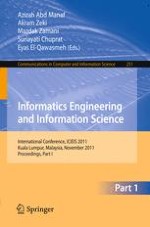This 4-Volume-Set, CCIS 0251 - CCIS 0254, constitutes the refereed proceedings of the International Conference on Informatics Engineering and Information Science, ICIEIS 2011, held in Kuala Lumpur, Malaysia, in November 2011. The 210 revised full papers presented together with invited papers in the 4 volumes were carefully reviewed and selected from numerous submissions. The papers are organized in topical sections on e-learning, information security, software engineering, image processing, algorithms, artificial intelligence and soft computing, e-commerce, data mining, neural networks, social networks, grid computing, biometric technologies, networks, distributed and parallel computing, wireless networks, information and data management, web applications and software systems, multimedia, ad hoc networks, mobile computing, as well as miscellaneous topics in digital information and communications.
